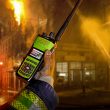Jurisdictional changes needed for 911
Tip O’Neil, former Speaker of the House, once said, “All politics is local.” Surely he didn’t have the 911 system in mind when he made that statement, but the expression could not have been more true for 911 — in the past.
All 911 was local, and the local government paid for and oversaw the system. All 911 calls were from fixed locations with known local addresses and area codes, and the only entities that really needed to know how to manage the system were the phone company, the customer premises equipment (CPE) vendor and local government leaders.
Then came wireless E911 — which, unfortunately, we are still working to complete — voice over IP (VoIP) and other emerging technologies and wireless networks. A lot already has been said about the need to modernize our nation’s 911 system to accommodate these new technologies: nomadic and wireless VoIP, telematics, video and camera phones, text and instant messaging, video and IP-relay services used by the deaf and hard of hearing, Wi-Fi and WiMAX — and the list goes on. Public-safety answering points (PSAPs) already are being asked to answer calls from some of these new devices and will be expected to continue to adapt with the changing communications trends of our society. Will our 911 system be flexible enough to accommodate the technologies our children’s children will use?
One thing is clear: The system will not be flexible enough to adapt to future needs unless it evolves toward a next-generation 911 (NG911) system to take full advantage of modern IP-based technology.
According to NENA, NG911 is “an IP-based replacement for E911 features and functions, supporting all sources of emergency access to the appropriate public-safety agency (or agencies), operating on managed, multi-purpose IP networks and providing expanded multimedia data capabilities for PSAPs and other emergency communications entities.” That is a whole lot more complicated than the origins of 911, and it involves a lot more players than the phone company, CPE vendor and the city council.
As we migrate to NG911, many of our past understandings of the 911 system must be redefined. 911 will remain a locally run service where local calls are answered by local call takers and a response is provided by local emergency responders. But the underlying technology and policy considerations that will enable the public to connect to a 911 system “anywhere, anytime, on any device” will likely not look like they do today. NG911 will enable 911 calls to be routed over secure, multi-use local, regional or state IP-networks that are shared among PSAPs, law enforcement, fire services, hospitals, schools and other non-public-safety users. In addition, to increased access to 911 from data and video sources from the emergency-calling public, PSAPs will better be able to share information with other emergency-response agencies. Clearly the requirements, security and rights of public-safety users on such a shared IP-network will be different than those of non-public-safety users.
How the network is set up and who gets access requires significant management, and it requires national standards and interfaces to enable sharing among all authorized users on the network and among other inter-networked entities from around the country, or even the world. A significant number of jurisdictional issues are raised in this scenario that must be answered as we move forward. What is the proper role of local, state and federal government in this environment?
All of this necessitates an entirely new way of thinking. It will require at the state level increased leadership, management and cooperation (not control, as 911 call handling and response is, and will remain, a local responsibility), as well as local and regional public/private partnerships to expand beyond those that exist today. And it will require more attention being paid to the development of consistent policies, regulations and standards at the national level. To that extent, 911 is most certainly not a local service any more.
David Jones is NENA’s past president and director of emergency services for Spartanburg County, S.C.

















